University Law Assignment: Negligence Law and Legal Defenses Analysis
VerifiedAdded on 2022/11/16
|6
|1228
|408
Homework Assignment
AI Summary
This assignment explores the legal concept of negligence, focusing on the essential elements required for a successful claim. It begins by examining whether Anna can successfully sue Michael for negligence, referencing key cases such as D'Arcy v Corporation of the Synod of the Diocese of Brisbane and Liverpool Catholic Club Ltd v Moor to illustrate the concept of duty of care. The assignment then delves into the core components of negligence, as established in Donoghue v Stevenson, including duty of care, violation of duty, causation (using the 'but for' test), and remoteness of damage. It highlights relevant cases like Caparo Industries PLC v Dickman, Alcock v Chief Constable of South Yorkshire Police, and The Wagon Mound no 1 to explain each element. Finally, the assignment outlines potential defenses Michael could use against Anna's claim, such as contributory negligence and volenti non fit injuria, referencing the Civil Liability Act of 1936. The assignment provides a comprehensive overview of negligence law, supported by case law and legal principles.
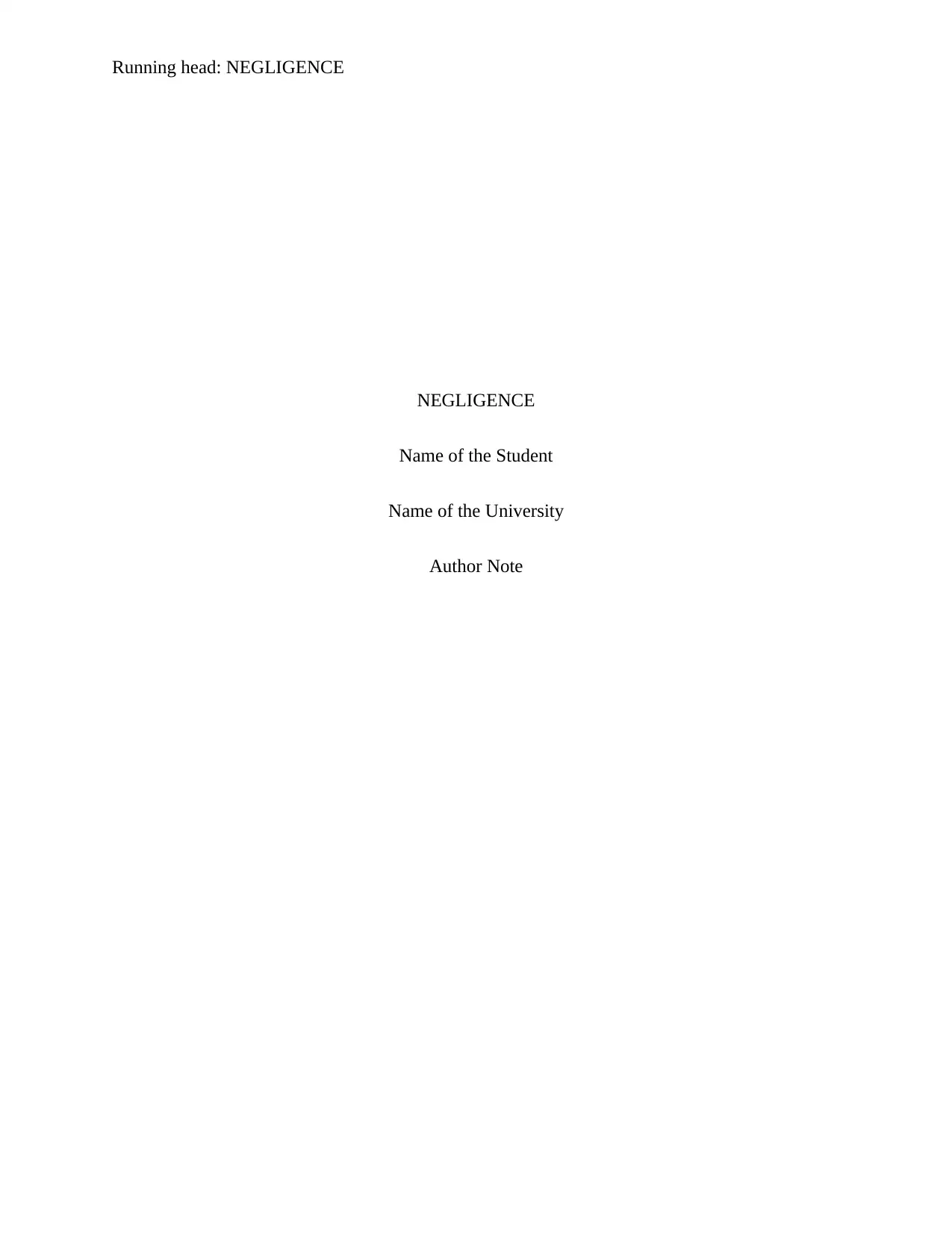
Running head: NEGLIGENCE
NEGLIGENCE
Name of the Student
Name of the University
Author Note
NEGLIGENCE
Name of the Student
Name of the University
Author Note
Paraphrase This Document
Need a fresh take? Get an instant paraphrase of this document with our AI Paraphraser
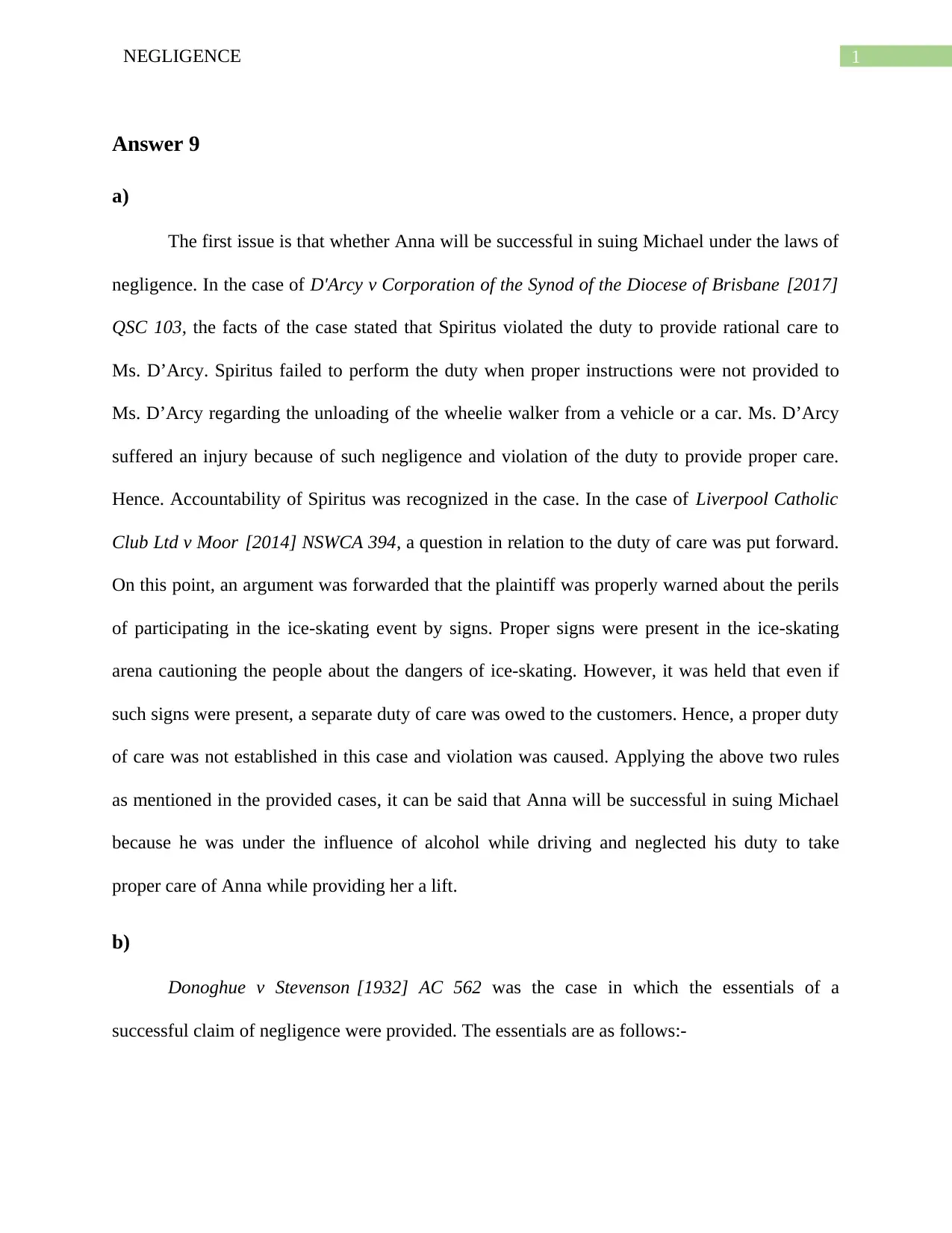
1NEGLIGENCE
Answer 9
a)
The first issue is that whether Anna will be successful in suing Michael under the laws of
negligence. In the case of D'Arcy v Corporation of the Synod of the Diocese of Brisbane [2017]
QSC 103, the facts of the case stated that Spiritus violated the duty to provide rational care to
Ms. D’Arcy. Spiritus failed to perform the duty when proper instructions were not provided to
Ms. D’Arcy regarding the unloading of the wheelie walker from a vehicle or a car. Ms. D’Arcy
suffered an injury because of such negligence and violation of the duty to provide proper care.
Hence. Accountability of Spiritus was recognized in the case. In the case of Liverpool Catholic
Club Ltd v Moor [2014] NSWCA 394, a question in relation to the duty of care was put forward.
On this point, an argument was forwarded that the plaintiff was properly warned about the perils
of participating in the ice-skating event by signs. Proper signs were present in the ice-skating
arena cautioning the people about the dangers of ice-skating. However, it was held that even if
such signs were present, a separate duty of care was owed to the customers. Hence, a proper duty
of care was not established in this case and violation was caused. Applying the above two rules
as mentioned in the provided cases, it can be said that Anna will be successful in suing Michael
because he was under the influence of alcohol while driving and neglected his duty to take
proper care of Anna while providing her a lift.
b)
Donoghue v Stevenson [1932] AC 562 was the case in which the essentials of a
successful claim of negligence were provided. The essentials are as follows:-
Answer 9
a)
The first issue is that whether Anna will be successful in suing Michael under the laws of
negligence. In the case of D'Arcy v Corporation of the Synod of the Diocese of Brisbane [2017]
QSC 103, the facts of the case stated that Spiritus violated the duty to provide rational care to
Ms. D’Arcy. Spiritus failed to perform the duty when proper instructions were not provided to
Ms. D’Arcy regarding the unloading of the wheelie walker from a vehicle or a car. Ms. D’Arcy
suffered an injury because of such negligence and violation of the duty to provide proper care.
Hence. Accountability of Spiritus was recognized in the case. In the case of Liverpool Catholic
Club Ltd v Moor [2014] NSWCA 394, a question in relation to the duty of care was put forward.
On this point, an argument was forwarded that the plaintiff was properly warned about the perils
of participating in the ice-skating event by signs. Proper signs were present in the ice-skating
arena cautioning the people about the dangers of ice-skating. However, it was held that even if
such signs were present, a separate duty of care was owed to the customers. Hence, a proper duty
of care was not established in this case and violation was caused. Applying the above two rules
as mentioned in the provided cases, it can be said that Anna will be successful in suing Michael
because he was under the influence of alcohol while driving and neglected his duty to take
proper care of Anna while providing her a lift.
b)
Donoghue v Stevenson [1932] AC 562 was the case in which the essentials of a
successful claim of negligence were provided. The essentials are as follows:-
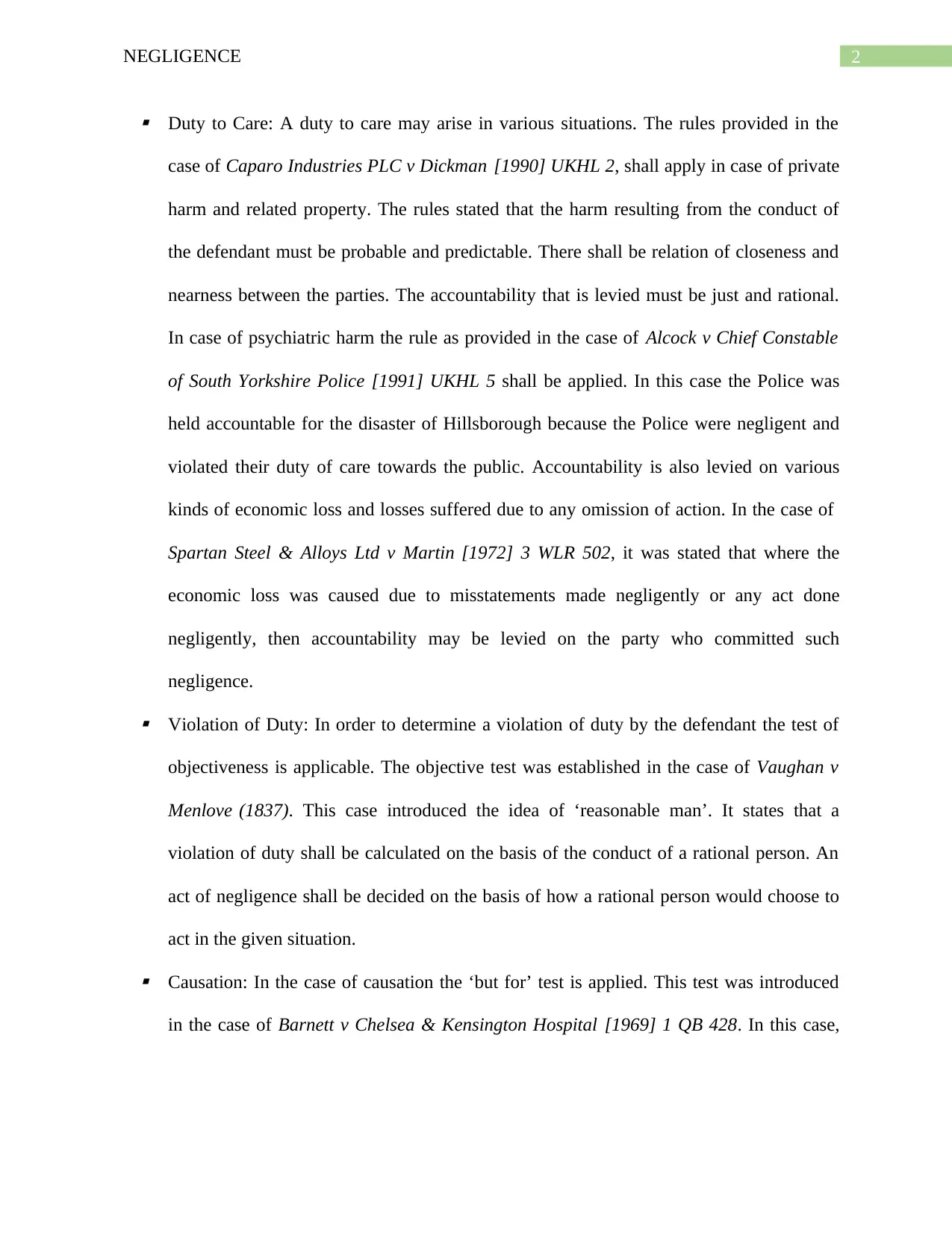
2NEGLIGENCE
Duty to Care: A duty to care may arise in various situations. The rules provided in the
case of Caparo Industries PLC v Dickman [1990] UKHL 2, shall apply in case of private
harm and related property. The rules stated that the harm resulting from the conduct of
the defendant must be probable and predictable. There shall be relation of closeness and
nearness between the parties. The accountability that is levied must be just and rational.
In case of psychiatric harm the rule as provided in the case of Alcock v Chief Constable
of South Yorkshire Police [1991] UKHL 5 shall be applied. In this case the Police was
held accountable for the disaster of Hillsborough because the Police were negligent and
violated their duty of care towards the public. Accountability is also levied on various
kinds of economic loss and losses suffered due to any omission of action. In the case of
Spartan Steel & Alloys Ltd v Martin [1972] 3 WLR 502, it was stated that where the
economic loss was caused due to misstatements made negligently or any act done
negligently, then accountability may be levied on the party who committed such
negligence. Violation of Duty: In order to determine a violation of duty by the defendant the test of
objectiveness is applicable. The objective test was established in the case of Vaughan v
Menlove (1837). This case introduced the idea of ‘reasonable man’. It states that a
violation of duty shall be calculated on the basis of the conduct of a rational person. An
act of negligence shall be decided on the basis of how a rational person would choose to
act in the given situation. Causation: In the case of causation the ‘but for’ test is applied. This test was introduced
in the case of Barnett v Chelsea & Kensington Hospital [1969] 1 QB 428. In this case,
Duty to Care: A duty to care may arise in various situations. The rules provided in the
case of Caparo Industries PLC v Dickman [1990] UKHL 2, shall apply in case of private
harm and related property. The rules stated that the harm resulting from the conduct of
the defendant must be probable and predictable. There shall be relation of closeness and
nearness between the parties. The accountability that is levied must be just and rational.
In case of psychiatric harm the rule as provided in the case of Alcock v Chief Constable
of South Yorkshire Police [1991] UKHL 5 shall be applied. In this case the Police was
held accountable for the disaster of Hillsborough because the Police were negligent and
violated their duty of care towards the public. Accountability is also levied on various
kinds of economic loss and losses suffered due to any omission of action. In the case of
Spartan Steel & Alloys Ltd v Martin [1972] 3 WLR 502, it was stated that where the
economic loss was caused due to misstatements made negligently or any act done
negligently, then accountability may be levied on the party who committed such
negligence. Violation of Duty: In order to determine a violation of duty by the defendant the test of
objectiveness is applicable. The objective test was established in the case of Vaughan v
Menlove (1837). This case introduced the idea of ‘reasonable man’. It states that a
violation of duty shall be calculated on the basis of the conduct of a rational person. An
act of negligence shall be decided on the basis of how a rational person would choose to
act in the given situation. Causation: In the case of causation the ‘but for’ test is applied. This test was introduced
in the case of Barnett v Chelsea & Kensington Hospital [1969] 1 QB 428. In this case,
⊘ This is a preview!⊘
Do you want full access?
Subscribe today to unlock all pages.

Trusted by 1+ million students worldwide
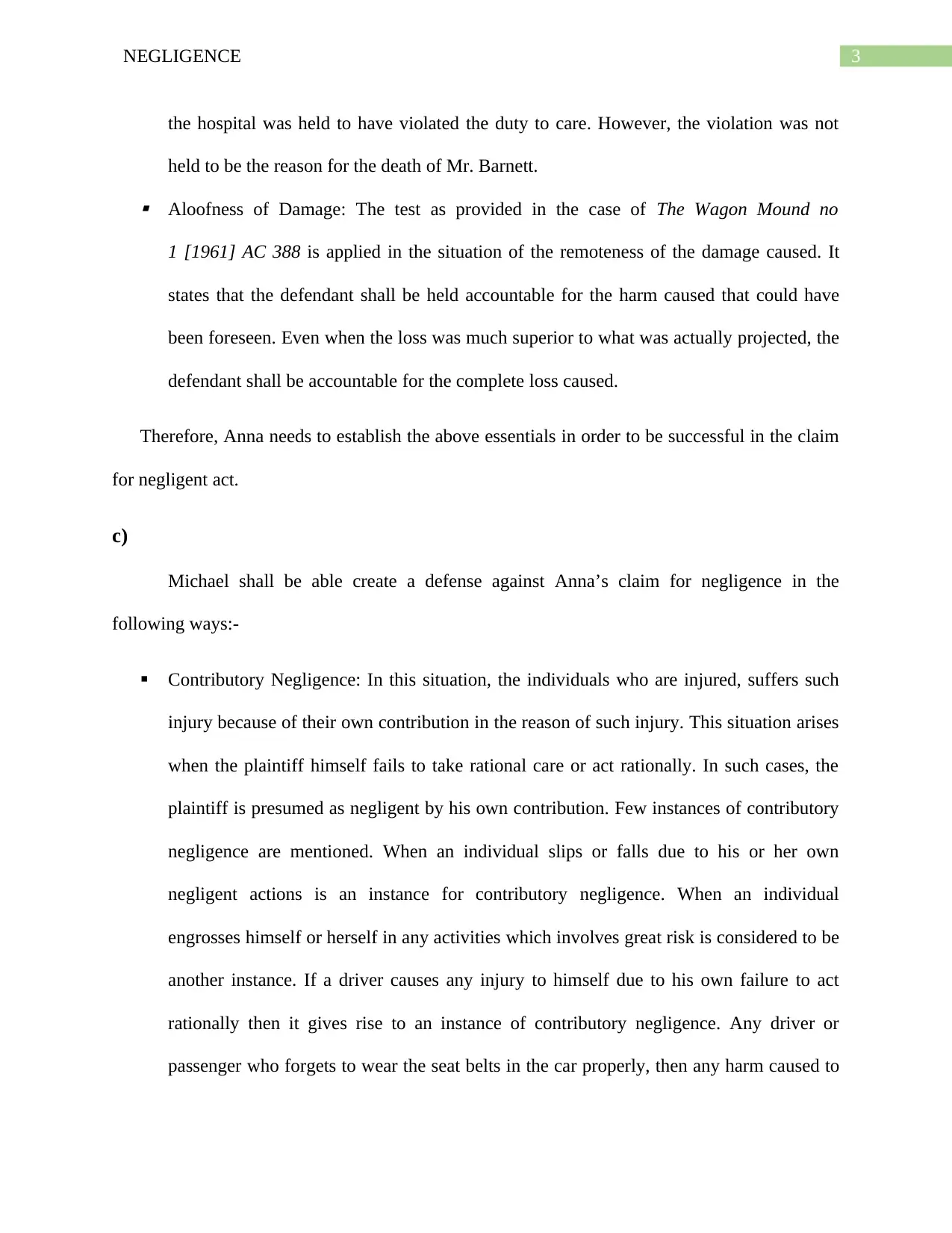
3NEGLIGENCE
the hospital was held to have violated the duty to care. However, the violation was not
held to be the reason for the death of Mr. Barnett. Aloofness of Damage: The test as provided in the case of The Wagon Mound no
1 [1961] AC 388 is applied in the situation of the remoteness of the damage caused. It
states that the defendant shall be held accountable for the harm caused that could have
been foreseen. Even when the loss was much superior to what was actually projected, the
defendant shall be accountable for the complete loss caused.
Therefore, Anna needs to establish the above essentials in order to be successful in the claim
for negligent act.
c)
Michael shall be able create a defense against Anna’s claim for negligence in the
following ways:-
Contributory Negligence: In this situation, the individuals who are injured, suffers such
injury because of their own contribution in the reason of such injury. This situation arises
when the plaintiff himself fails to take rational care or act rationally. In such cases, the
plaintiff is presumed as negligent by his own contribution. Few instances of contributory
negligence are mentioned. When an individual slips or falls due to his or her own
negligent actions is an instance for contributory negligence. When an individual
engrosses himself or herself in any activities which involves great risk is considered to be
another instance. If a driver causes any injury to himself due to his own failure to act
rationally then it gives rise to an instance of contributory negligence. Any driver or
passenger who forgets to wear the seat belts in the car properly, then any harm caused to
the hospital was held to have violated the duty to care. However, the violation was not
held to be the reason for the death of Mr. Barnett. Aloofness of Damage: The test as provided in the case of The Wagon Mound no
1 [1961] AC 388 is applied in the situation of the remoteness of the damage caused. It
states that the defendant shall be held accountable for the harm caused that could have
been foreseen. Even when the loss was much superior to what was actually projected, the
defendant shall be accountable for the complete loss caused.
Therefore, Anna needs to establish the above essentials in order to be successful in the claim
for negligent act.
c)
Michael shall be able create a defense against Anna’s claim for negligence in the
following ways:-
Contributory Negligence: In this situation, the individuals who are injured, suffers such
injury because of their own contribution in the reason of such injury. This situation arises
when the plaintiff himself fails to take rational care or act rationally. In such cases, the
plaintiff is presumed as negligent by his own contribution. Few instances of contributory
negligence are mentioned. When an individual slips or falls due to his or her own
negligent actions is an instance for contributory negligence. When an individual
engrosses himself or herself in any activities which involves great risk is considered to be
another instance. If a driver causes any injury to himself due to his own failure to act
rationally then it gives rise to an instance of contributory negligence. Any driver or
passenger who forgets to wear the seat belts in the car properly, then any harm caused to
Paraphrase This Document
Need a fresh take? Get an instant paraphrase of this document with our AI Paraphraser
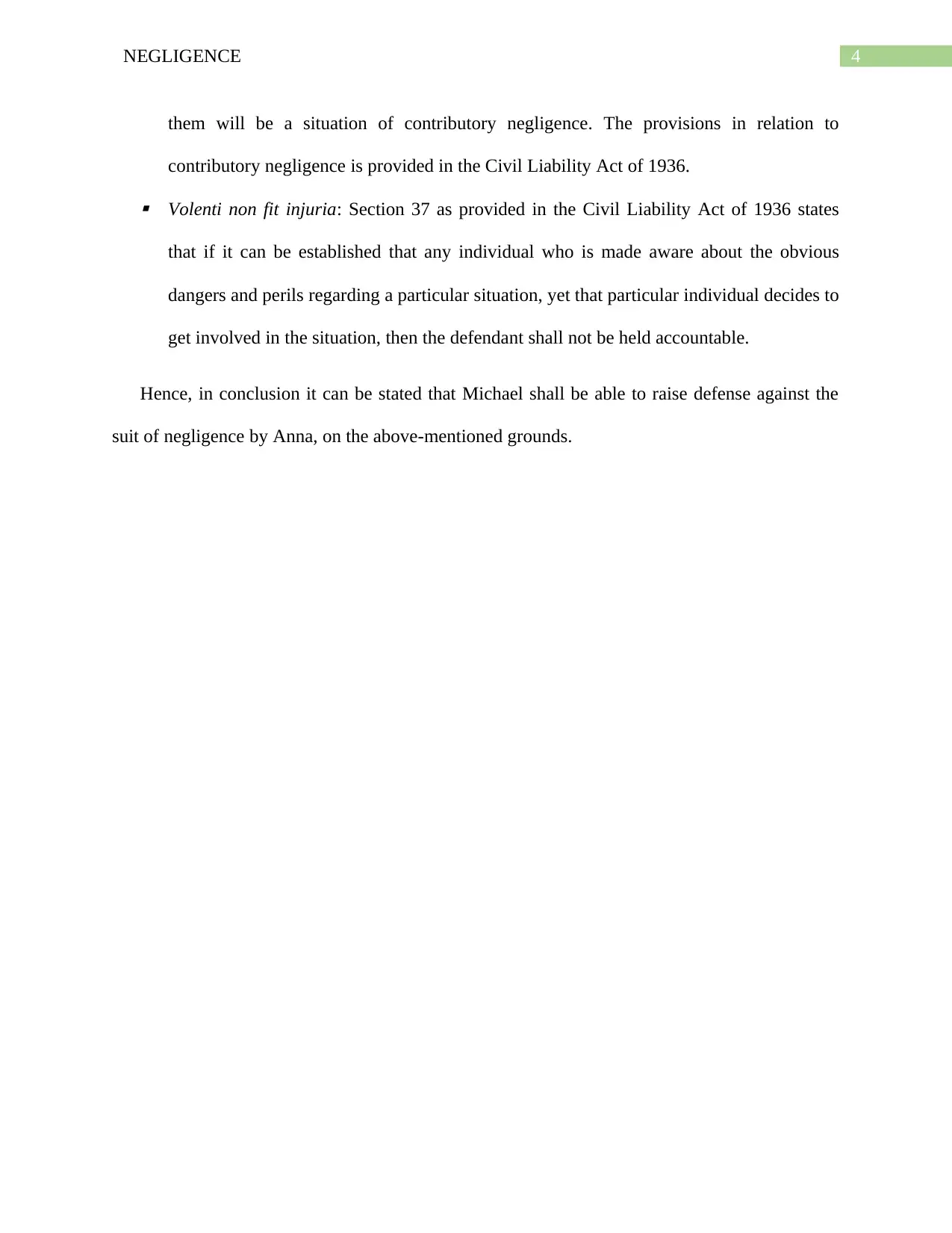
4NEGLIGENCE
them will be a situation of contributory negligence. The provisions in relation to
contributory negligence is provided in the Civil Liability Act of 1936. Volenti non fit injuria: Section 37 as provided in the Civil Liability Act of 1936 states
that if it can be established that any individual who is made aware about the obvious
dangers and perils regarding a particular situation, yet that particular individual decides to
get involved in the situation, then the defendant shall not be held accountable.
Hence, in conclusion it can be stated that Michael shall be able to raise defense against the
suit of negligence by Anna, on the above-mentioned grounds.
them will be a situation of contributory negligence. The provisions in relation to
contributory negligence is provided in the Civil Liability Act of 1936. Volenti non fit injuria: Section 37 as provided in the Civil Liability Act of 1936 states
that if it can be established that any individual who is made aware about the obvious
dangers and perils regarding a particular situation, yet that particular individual decides to
get involved in the situation, then the defendant shall not be held accountable.
Hence, in conclusion it can be stated that Michael shall be able to raise defense against the
suit of negligence by Anna, on the above-mentioned grounds.
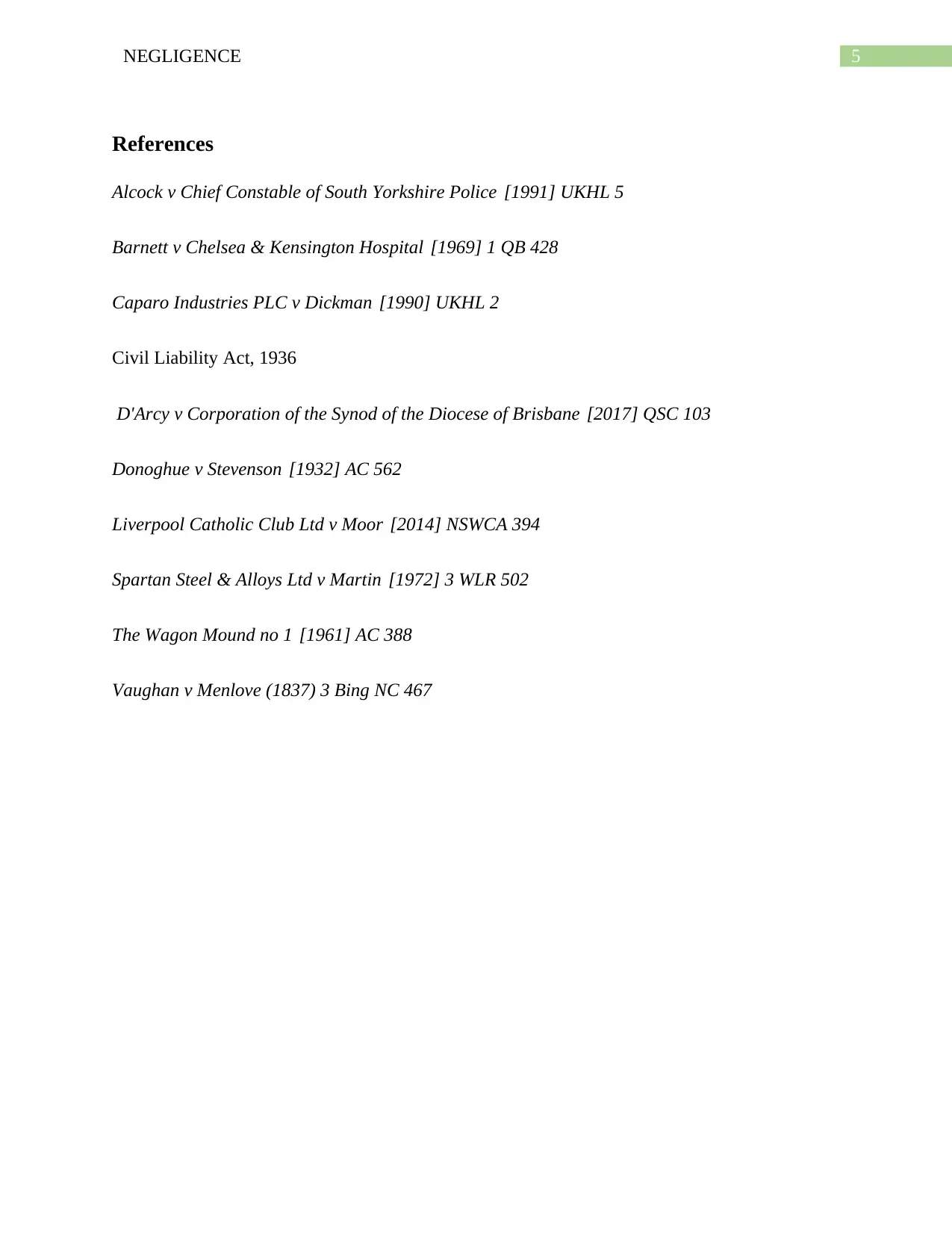
5NEGLIGENCE
References
Alcock v Chief Constable of South Yorkshire Police [1991] UKHL 5
Barnett v Chelsea & Kensington Hospital [1969] 1 QB 428
Caparo Industries PLC v Dickman [1990] UKHL 2
Civil Liability Act, 1936
D'Arcy v Corporation of the Synod of the Diocese of Brisbane [2017] QSC 103
Donoghue v Stevenson [1932] AC 562
Liverpool Catholic Club Ltd v Moor [2014] NSWCA 394
Spartan Steel & Alloys Ltd v Martin [1972] 3 WLR 502
The Wagon Mound no 1 [1961] AC 388
Vaughan v Menlove (1837) 3 Bing NC 467
References
Alcock v Chief Constable of South Yorkshire Police [1991] UKHL 5
Barnett v Chelsea & Kensington Hospital [1969] 1 QB 428
Caparo Industries PLC v Dickman [1990] UKHL 2
Civil Liability Act, 1936
D'Arcy v Corporation of the Synod of the Diocese of Brisbane [2017] QSC 103
Donoghue v Stevenson [1932] AC 562
Liverpool Catholic Club Ltd v Moor [2014] NSWCA 394
Spartan Steel & Alloys Ltd v Martin [1972] 3 WLR 502
The Wagon Mound no 1 [1961] AC 388
Vaughan v Menlove (1837) 3 Bing NC 467
⊘ This is a preview!⊘
Do you want full access?
Subscribe today to unlock all pages.

Trusted by 1+ million students worldwide
1 out of 6
Your All-in-One AI-Powered Toolkit for Academic Success.
+13062052269
info@desklib.com
Available 24*7 on WhatsApp / Email
![[object Object]](/_next/static/media/star-bottom.7253800d.svg)
Unlock your academic potential
Copyright © 2020–2025 A2Z Services. All Rights Reserved. Developed and managed by ZUCOL.
